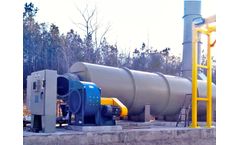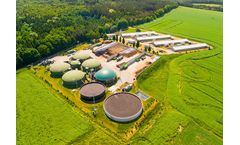Showing results for: waste-to-hydrogen Articles
-
Upscaling of Innovative Green Hydrogen Applications - Case study
In recent years, production of green hydrogen (hydrogen produced without associated greenhouse gas emissions) has received growing support from European Union policy bodies, in order to establish and develop a hydrogen economy and to aid in security of energy supply for Europe. One method of producing green hydrogen is of course, electrolysis of water, but there are also other ways to produce ...
-
Enhancement of hydrogen production from Kitchen Waste using heat treated anaerobic biogas plant slurry with pH control
Hydrogen is found to be a clean energy source; biohydrogen has been researched in recent years. Anaerobic Digestion of Kitchen Waste (KW) for hydrogen production was performed in lab scale reactors, using heat-treated anaerobically digested biogas plant slurry. The biogas plant slurry was given heat treatment at varying temperatures ranging from 70 to 100 ° C for 15 min. Enhancement of hydrogen ...
-
Proton Power 25m3 DIY Syngas Storage
Based in Tennessee USA Proton Power Inc. (PPI) was founded by 2 remarkable entrepreneurs with previous successes in such diverse areas as aircraft brakes and neutron absorbers (don’t ask!). With this kind of history we knew their requirement was going to be beyond our usual scope. We weren’t wrong - they requested a 25m3 Base gas holder in which to store a syngas mixture with high ...
-
Transformer Oil Hydrotreating case study
Hydrogenation of waste transformer oil (electrical insulating oils) can produce an oil product that is far better in quality and yield in comparison with fixed bed clay adsorption or reaction with sodium metal. This is proven at Sequoia- client’s facility in Midwestern USA. The 5 million gallon/year throughput naphthenic oil hydrotreater produces oil free of PCBs (polychlorobiphenyls ...
-
Valorising By-Product Hydrogen - Case Study
Overview Electrochemical processes, such as the industrial production of caustic soda and chlorine, use large quantities of electricity which contribute significantly to production costs, up to 70% in some cases. They also produce hydrogen as a waste product (see diagram), which is either combusted or vented to the atmosphere. Fuel cells offer a highly efficient method of utilising this ...
-
Effect of various micro-porous layer preparation methods on the performance of a proton exchange membrane fuel cell
Proton exchange membrane fuel cells (PEMFCs) have been widely studied and discussed in the field of energy owing to their high energy efficiency and low waste emissions. A PEMFC uses hydrogen gas as a fuel, and works by causing hydrogen ions to link up with oxygen, producing liquid water as its sole by-product. The design of a PEMFC's micro-porous layer (MPL) can not only enhance cell ...
-
Tronox Namakwa sands furnace Gas CHP Plant - Case Study
Tronox is the largest fully integrated producer of titanium ore and titanium dioxide in the world. The Tronox Mineral Sands cogeneration power generation plant, located in the Western Cape, uses the waste gas from two open arc DC furnaces as an energy source. The gas engine power plant operates on waste gas produced by titanium melting. The facility consists of 8 of GE’s JMS620GS-SL ...
-
Exergetic performance assessment of gasification and pyrolysis processes of pre-treated wood board wastes
This paper investigates exergetic performance of gasification and pyrolysis processes and compares their exergy efficiencies, using the experimental data on a two-step process of thermo-chemical conversion of Wood Board (WB) wastes. The exergy values of biomass samples change from 17.49 MJ/kg to 24.57 MJ/kg, respectively. Hydrogen produced from pyrolysis step of gasification varies between 17 ...
-
Enclosed Flare Abates Waste Acid Gas for Midstream Amine Facility
Initial Operating IssueA midstream gas processing facility was evaluating the purchase and installation of new air pollution control equipment to intermittently treat waste acid gas exhaust from one of their amine units located in New Mexico. During normal plant operation, this waste acid gas exhaust stream containing Hydrogen Sulfide, CO2, Methane and other VOCs was compressed and injected into ...
-
Oil Chiefs Clash over Energy and Climate
Conflicting messages about how the oil industry should respond to climate change and manage its reputation have been sent out by the heads of three oil majors - ExxonMobil, Shell and ChevronTexaco. None foresees a challenge to the supremacy of oil and gas for the next three decades - but on many other issues the transatlantic rift runs deep. ExxonMobil remains the target for a global campaign ...
-
Using Anaerobic Biomass Digestion to Produce Hydrogen and Biofuel
For many years, hydrogen has been considered as an alternative to fossil fuels. Now, Scientists are aiming to develop an environmentally friendly method to produce hydrogen from biomass by optimizing anaerobic digestion systems.1 Climate change, dwindling fuel resources and energy prices have spearheaded intensive efforts to detect and optimize alternative fuel options. As a zero emission ...
-
Using Anaerobic Biomass Digestion to Produce Hydrogen and Biofuel
For many years, hydrogen has been considered as an alternative to fossil fuels. Now, Scientists are aiming to develop an environmentally friendly method to produce hydrogen from biomass by optimizing anaerobic digestion systems.1 Climate change, dwindling fuel resources and energy prices have spearheaded intensive efforts to detect and optimize alternative fuel options. As a zero emission fuel, ...
Need help finding the right suppliers? Try XPRT Sourcing. Let the XPRTs do the work for you




